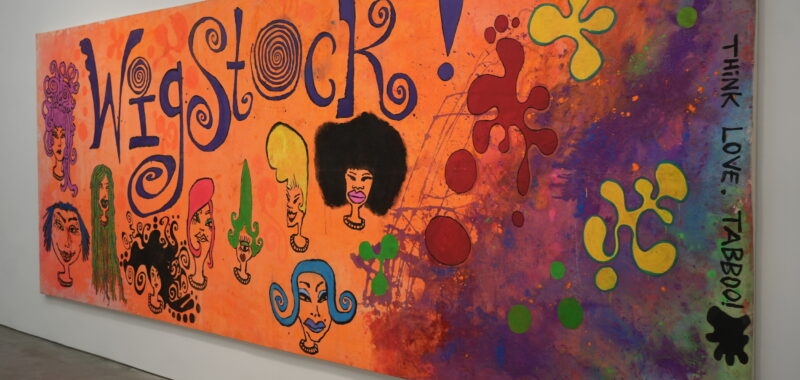There’s an infectious energy in Tabboo!’s early paintings that instantly summons the underground queer culture of 1980s New York: mid-century curlicues abut comic book figures in a brash palette with psychedelic splashes on paper and canvas, screaming, look at me! These are part of the materialistic and rambunctious universe that the 1980s East Village built, and we see more recent flowerings from that great cultural experiment in everything from RuPaul’s Drag Race — RuPaul was part of that scene — to the DIY culture of Etsy. Tabboo! (aka Stephen Tashjian) was an influential early figure. He was a regular performer at the infamous Pyramid Club, where pop culture icons like Madonna, Lady Bunny, and Nirvana also appeared, and the subject of artworks including a number of Nan Goldin’s photographs. Karma and Gordon Robichaux, two Manhattan galleries, are each devoting two gallery spaces to his artistic world, giving him the chance to shine solo.
Some of these works were originally created as advertising, while others are more muted (though never that muted) ruminations on people or things. At the center of the largest display, at Karma’s 188 East 2nd Street space, is a large 1990 banner for Wigstock, a drag festival started in 1984 that took place on Labor Day with few interruptions until 2005, which has been restored by the gallery to its initial vibrancy. The work encapsulates Tashjian’s overall aesthetic perfectly, with its fluorescent hues, fantastical heads or wigstands, amorphous shapes, and hand-drawn lettering floating in a universe of his own making. While the banner alone is a major draw to this expansive display of early work, we also get a deep dive into the drawings and paintings that became posters, postcards, and other ephemera for the shows and festivities that made up the social calendar of the gay and drag-inclined East Village social scene — all of it is worthwhile.

Some of the cast of that period, from designer Patricia Field to artist Keith Haring, also appear in these drawings and paintings, but I found the more curious and intimate works, like “Self-Portrait in Drag as Popcorn” (1983), “2 Queens ‘reading’ Dish” (1985), or “Self Portrait with Cocktail” (1987) to be the highlights of the shows for their sensitive treatment of more intimate moments.
There’s a clear contrast between the work designed for others and those that seem to have a more personal meaning, particularly the self-portraits that he renders with a roughshod energy that lets his style loosen — “Untitled (Self-Portrait)” (1982) on board is a good example. In another work of the same name but created on paper, the artist depicts himself looking up at a galaxy of colorful smudges and drops with a sense of dizzying awe. He’s holding what could be a cigarette, joint, or a crayon, and it’s in that moment that I recognize the energy that underlies his best work and probably some of his finest drag: the idea that from a single mark, smudge, or action, a whole world can be born.



Tabboo!: Early Works continues at Karma gallery (188 & 172 East 2nd Street, Lower East Side, Manhattan) until March 1 and at Gordon Robichaux gallery (41 Union Square West, #925 and #907, Union Square, Manhattan) through February 28.

